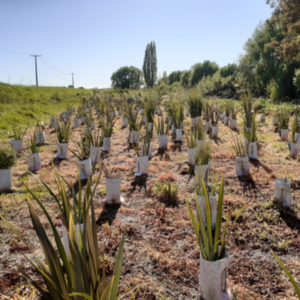Tasman District Council’s native riparian planting
The Tasman District Council’s River Management team plants around 15,000 native plants each year along river riparian margins thoughout the region. These riparian plants play a role in stabilising riverbanks and enhancing biodiversity.

The majority of the plants used are hardy, fast-growing natives such as harakeke (flax), toetoe, tī kōuka (cabbage trees), mānuka, kānuka, mānatu (ribbonwood), houhere (lacebark), kōhūhū (pittosporum), coprosmas, hebe, and ake ake. Once these initial plantings are established, longer-living forest trees like rimu, kahikatea, miro, matai and some beech varieties are introduced to create a more mature, diverse ecosystem.

The primary focus is on maintaining and expanding existing planting sites, with an emphasis on improving publicly accessible areas on rivers. The planting sites also provide other benefits with the trees acting as a flood flow filter buffer zone, and the root systems assist in improving bank stability. Around 10,000 native trees and shrubs have been planted in riparian areas in the Motueka Catchment this year, with more to be planted in 2025. Main areas of planting include a site in the Graham Valley, Blue Gum Corner, Coles Beach, the Pokororo River, and adjacent to sections of the cycle trail. An example of a thriving planting that was established approximately 2 years ago is the riparian planting around the Alexander Bluff Bridge, which has helped enhance this popular swimming spot.
Riparian planting is something the MCC is very keen to see happening along the rivers and tributaries in the Motueka catchment. It is one of the key positive actions that can improve freshwater health, so it’s great to hear about the TDC’s work to support this.

